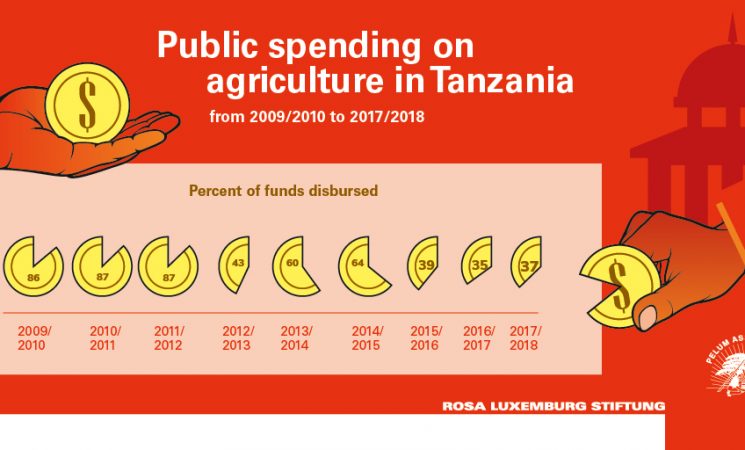The State Matters: Government Spending on Agriculture in Tanzania and Zambia
A joint report by Rosa-Luxemburg-Stiftung, PELUM Tanzania and PELUM Zambia
The agricultural sector plays an integral role in African countries, firstly by producing sufficient food and secondly as a source of livelihoods and incomes across the rural and urban divide, and ultimately contributing to poverty reduction, health and well-being. Analysing the different aspects of public spending on agriculture in Tanzania and Zambia, the authors of this report, jointly published by the Rosa-Luxemburg-Siftung, PELUM Tanzania and PELUM Zambia, argue that the public expenditure on agriculture matters because the share of national budgets earmarked for the sector, and how tactically and efficiently funds are allocated, have far-reaching implications for both agriculture as a whole and the survival of the millions of small-scale food producers that depend on the sector for their livelihoods and food security.
Understanding key spending trends and how government expenditures on agriculture are performing
Over the past two to three decades, public expenditure on agriculture declined steadily as the “spending policies” of many African countries have undergone massive changes, mainly due to the influence of donor governments and multilateral institutions such as the International Monetary Fund and the World Bank. Whereas states previously intervened in the agricultural sector, for instance, with active pricing policies and other measures, nowadays the state is expected to provide a more prosperous environment for private sector investment. In Tanzania, for example, the national budget allocation for agriculture fluctuated significantly between 2010 and 2020 increasing from 3% in 2001/2002 and peaking at 7.8 % in 2010/2011 before hitting a steady decline from 2012/2013 onwards. In Zambia, between 2010 and 2021 the agricultural sector was allocated less than 10 % of Zambia’s national budget.
In both countries, under-disbursement, and which occurs when government ministries and agencies do not receive the budget allocation stated in the annual state of funds remains key challenge. Moreover, an assessment of the budget execution on agriculture in both countries also revealed persistent underspending of allocated state funds for agriculture that the national ministries of agriculture receive.
By delving deeper into the composition of public expenditure, this report highlights key trends and determine funding priorities. The analysis reveals that a large share of government spending in both countries goes into input support programmes that have concentrated on maize in particular, providing a package of Green Revolution inputs consisting of commercial seeds, synthetic fertlisers and pesticides as well as markets for a single crops and displacing other critical food crops that contribute to improved food access and nutrition. Maize accounted for circa 70 % of crop output and the largest portion of the planted area in Tanzania, followed by paddy rice covering almost 17%. The agricultural budget share towards farmer input subsidies in Zambia for examples between 2015 and 2021 varied between 33% and 80%. Meanwhile, the private sector has been the primary beneficiary, with the number of commercial seed and fertiliser companies growing and new local companies competing with established multinational corporations (MNCs) that dominate the sector. In general, farmer input subsidies impact the budget allocations for other agricultural programmes such as extension services, research and development, which also drive agricultural production and productivity.
Undoubtedly, increased food production and supply for local markets are imperative to counter the barrage of climate, political, financial and other crises affecting the cost and access to food, however, the current agricultural policies and strategies driving investment flows and public expenditure on agriculture raises much concern about the future of food and agriculture in Africa as a whole and in Tanzania and Zambia in particular
Political recommendations
The authors of this report advocate for purposeful and prudent use of public funds as a pragmatic pathway to transforming food systems in Africa. In order to do so public funding should be directed to:
- Environmental sustainability by protecting natural resources and the environment and directing public funds allocated for environmental management, including donor funding, to initiatives that promote agro-biodiversity.
- The resilience of agricultural systems reducing the use of inorganic fertilisers and pesticides and promoting agroecological alternatives instead.
- Targeting small-scale food producers, explicitly women and youths as target groups.
- Public research and extension services devised to promote and broaden the scope of agricultural research as well as increase the capacity of extension services
The report was written by Refiloe Joala, Rosa-Luxemburg-Stiftung Southern Africa Regional Office, Donati Senzia, PELUM Tanzania, Muketoi Wamunyima, PELUM Zambia and the content was edited by Jan Urhahn, Rosa-Luxemburg-Stiftung Southern Africa Regional Office.

